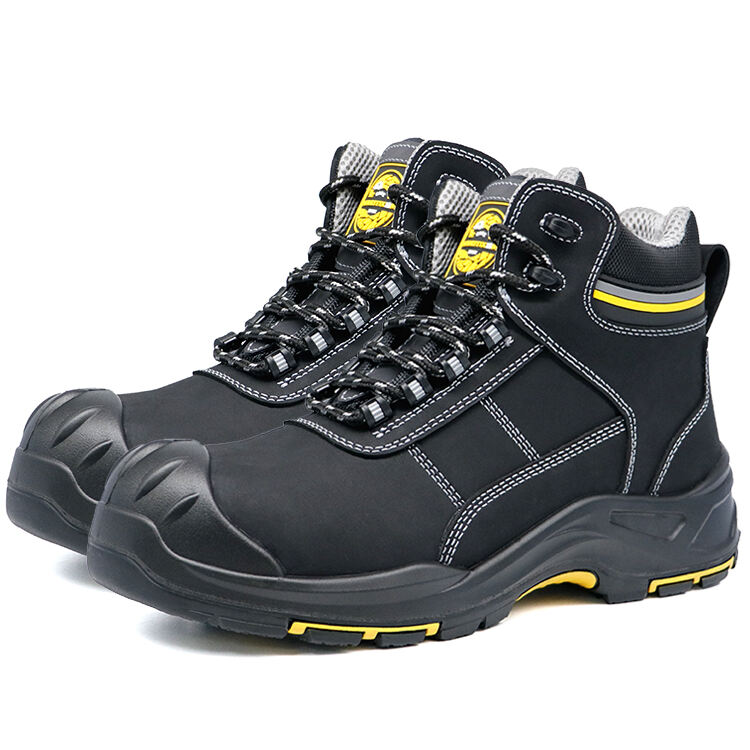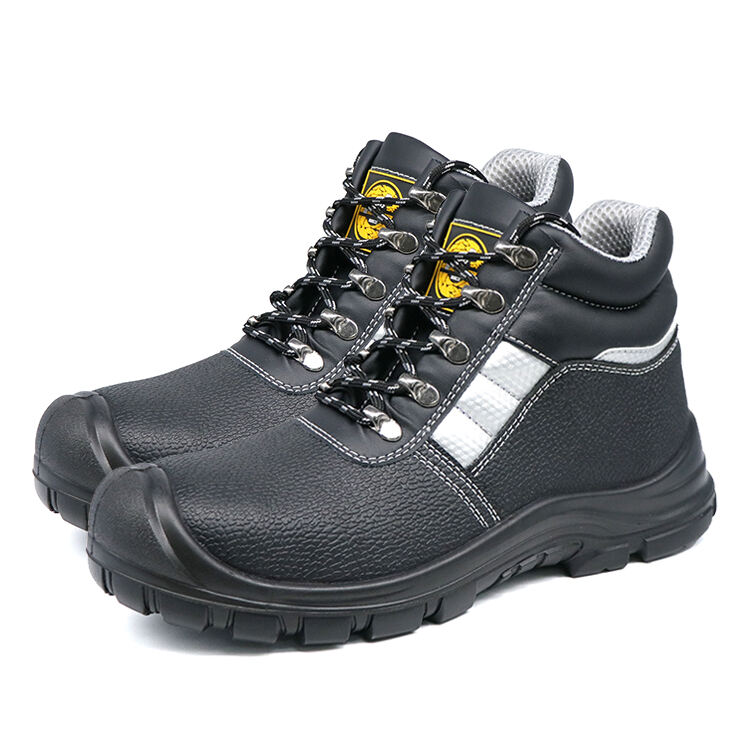
Steel Toe Boots: Protection and Durability for Harsh Work Environments
Why Steel Toe Boots Are Essential for Harsh Work Environments
Impact Protection Against Heavy Objects
Steel toe boots are paramount in providing impact protection against heavy objects, which is a critical aspect of workplace safety. Designed with reinforced steel caps, these boots offer a formidable barrier against items that may fall or roll onto the feet, significantly reducing the risk of serious injuries. According to safety studies, individuals wearing steel toe boots experience up to a 70% decrease in the likelihood of severe foot injuries in hazardous environments. This protection is especially vital in industries like construction, manufacturing, and logistics, where workers are constantly exposed to heavy machinery and equipment.
Durability in Extreme Conditions
Another compelling reason steel toe boots are essential is their durability in extreme conditions. Crafted from high-quality materials, these boots withstand the wear and tear inflicted by harsh weather conditions, exposure to chemicals, and rough terrains. The boots' longevity often surpasses that of regular work boots, making them a cost-effective choice over time. Whether navigating muddy construction sites or working with corrosive materials, steel toe boots offer unprecedented resilience, ensuring that workers remain protected no matter the challenge.
Compliance with OSHA Safety Standards
Steel toe boots also play a crucial role in compliance with OSHA safety standards. By meeting specific OSHA regulations, these boots ensure that workers adhere to essential safety guidelines while on the job. Compliance is not only a legal requirement but also a reassurance that workers are protected against potential hazards. Failure to comply with these standards can lead to costly fines and exponentially increase the risks for workers. Thus, investing in steel toe boots is an investment in both safety and financial prudence, aligning with industry standards and fostering safer workplaces.
Key Features of High-Performance Steel Toe Boots
Reinforced Steel Toe Caps vs. Composite Alternatives
When choosing between reinforced steel toe caps and composite toe alternatives, it's essential to consider the level of protection offered. Reinforced steel toe caps provide a robust shield against punctures and impacts, particularly in heavy-duty work environments. They offer uncompromising impact protection, which makes them ideal for industries where falling objects or punctures are common risks. On the other hand, composite toe alternatives prioritize a lighter, non-metallic build, making them an excellent choice for those who require a less restrictive fit. While they still deliver significant safety, they shine in scenarios where weight and metal detection are concerns.
Waterproofing Technology for Wet Environments
For those working in consistently wet environments, waterproof technology in work boots is a game changer. This technology ensures that feet remain dry and comfortable throughout the workday, which is crucial for maintaining not only comfort but also health. Research indicates a strong correlation between keeping feet dry and preventing conditions like trench foot. Moreover, dry feet significantly boost productivity, as workers can maintain focus without the distraction of discomfort. Investing in waterproof steel toe boots can profoundly enhance performance and wellness in wet, demanding workplaces.
Non-Slip Outsoles for Hazardous Surfaces
Non-slip outsoles are a critical feature in steel toe work boots, providing essential traction to navigate hazardous surfaces safely. Slip-resistant designs dramatically reduce the risk of falls, one of the most common accidents in workplace settings. Statistics consistently indicate that fall-related injuries remain a leading cause of workplace accidents, underscoring the importance of choosing non-slip safety footwear. High-performance steel toe boots equipped with such outsoles not only protect against slips but empower workers with the confidence to move safely across various challenging surfaces.
In conclusion, high-performance steel toe boots integrate vital features that prioritize safety and comfort. Whether you choose steel or composite toe caps, prioritize waterproof technology, or require non-slip outsoles, these elements collectively ensure that the boots support you effectively throughout your workday.
Steel Toe vs. Composite Toe: Choosing the Right Protection
Weight Comparison: Steel vs. Lightweight Safety Toe Shoes
When choosing between steel toe boots and lightweight safety toe shoes, weight is a key factor to consider. Steel toe boots, known for their robust construction, often have added weight due to their reinforced steel caps, which provide unparalleled protection against impacts. However, this weight can be challenging for workers who spend long hours on their feet. On the other hand, lightweight safety toe shoes, typically equipped with composite or alloy materials, offer enhanced comfort and flexibility. While they may trade off some protection compared to steel, they are easier to wear for extended periods and can prevent fatigue. Ultimately, the choice between these options should align with your specific job requirements and priorities for comfort.
Thermal Conductivity in Cold Environments
Thermal conductivity can significantly impact comfort levels in cold environments, making the choice between steel and composite toe boots crucial. Steel toe boots, due to their metal composition, can conduct cold temperatures, leading to discomfort during chilly weather conditions. This cold conduction can be problematic for workers who need to spend prolonged hours outdoors in the winter. In contrast, composite toe boots offer better thermal insulation, maintaining warmth for feet even in frigid conditions. Their non-metallic construction means they don't transmit cold as steel does, positioning them as a more suitable option for those working in colder climates.
Electrical Hazard Resistance
Choosing the right work boot for environments with electrical hazards is essential, making the decision between steel and composite toe boots important. Steel toe boots can pose a safety concern in electrical work environments due to their conductive properties, which might lead to increased risks for electricians or workers handling live wires. Composite toe boots, however, are often favored in such settings for their non-conductive nature. They provide superior electrical hazard resistance, ensuring safety for professionals exposed to electricity on a daily basis. Given their effectiveness in mitigating electrical risks, composite toe boots become the preferred choice for those working in sectors where electrical safety is a priority.
Maximizing Comfort in Steel Toe Work Boots
Ergonomic Design for All-Day Wear
Ergonomic design in steel toe work boots plays a crucial role in minimizing foot fatigue for workers who spend extended periods on their feet. This means that the boots are created to distribute weight evenly, reducing pressure points and enhancing comfort. When employees experience less discomfort, it leads to increased productivity and fewer breaks due to foot pain. Investing in ergonomic footwear is not just beneficial for the worker, but also for the overall efficiency of workplace operations.
Breathable Materials and Moisture Management
Incorporating breathable materials in steel toe boots is essential for maintaining comfort and minimizing health issues such as foot odor and fungal infections. By facilitating airflow, these materials help prevent moisture buildup, which is especially important in hot or humid working environments. Additionally, effective moisture management supports foot health by wicking away sweat, thereby keeping the feet dry throughout the workday. Ensuring that steel toe boots include these features can significantly enhance a worker’s comfort and well-being.
Break-In Periods and Fit Adjustments
Steel toe boots often require a break-in period, during which the materials mold to the shape of the wearer’s feet, enhancing comfort over time. It is important to be patient during this period, as it allows for a custom fit that adapts to individual contours. Moreover, making fit adjustments through lacing, insoles, or orthotics can further optimize support and comfort. These adjustments are vital for promoting foot health, particularly for individuals who rely on their steel toe boots throughout long work shifts.
Maintenance Tips for Long-Lasting Steel Toe Boots
Cleaning Waterproof Steel Toe Boots
Cleaning waterproof steel toe boots regularly is crucial in maintaining their protective features and extending their lifespan. The importance of keeping these boots clean cannot be overstated, as accumulated dirt and grime can degrade protective coatings over time. To achieve effective cleaning, it's essential to use appropriate products designed for waterproof materials. These specialized cleaners not only remove dirt but also help in preserving the boot's structural integrity. As a result, workers can be assured their boots will continue to perform optimally in demanding environments, thus ensuring safety and protection.
Replacing Worn Outsoles and Insoles
Routine inspection and replacement of worn-out outsoles and insoles is vital for maintaining optimal grip and comfort in steel toe boots. Regular wear and tear can diminish the effectiveness of these components, potentially compromising safety. It's advised to replace outsoles and insoles as soon as signs of wear appear. On average, a well-maintained pair of work boots can last between 6-12 months; however, this varies depending on use and care. By ensuring these components are in good condition, workers are more likely to experience enhanced stability and reduced fatigue, contributing to a safer workplace environment.
Storage Best Practices for Durability
Proper storage techniques play a significant role in enhancing the durability of steel toe boots. One of the best practices involves storing boots in a cool, dry place to maintain their shape and functionality. Exposure to dampness or extreme temperatures can lead to material degradation over time. Moreover, incorporating cedar shoe trees into storage can be beneficial, as they effectively absorb moisture and help keep the boots fresh. By following these storage best practices, one can significantly extend the lifespan of their boots, ensuring they remain in excellent condition and ready for use when needed.

 EN
EN
 AR
AR BG
BG HR
HR CS
CS DA
DA NL
NL FI
FI FR
FR DE
DE EL
EL HI
HI IT
IT JA
JA KO
KO NO
NO PL
PL RO
RO RU
RU ES
ES SV
SV TL
TL ID
ID SR
SR VI
VI HU
HU MT
MT TH
TH TR
TR AF
AF MS
MS GA
GA BN
BN NE
NE
